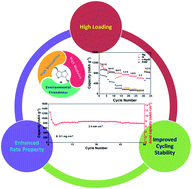A mechanically robust and high-wettability multifunctional network binder for high-loading Li–S batteries with an enhanced rate property†
Abstract
High-loading sulfur electrodes play a crucial role in the practical application of Li–S batteries. However, the poor mechanical stability and sluggish Li-ion conduction severely hinder the cycling stability and rate property of high-loading sulfur electrodes. PVDF binder has been widely used in Li–S batteries, while the coating process using PVDF binder requires toxic and expensive NMP solvent and the poor mechanical property of PVDF binder makes it incompetent as the binder for high-loading Li–S batteries. Herein, we use strong-affinity alginic acid (Alg) and high-wettability, high-modulus isosorbide (IS) to produce an environmentally friendly c-Alg-IS network binder via a condensation reaction for a high-loading sulfur electrode. As a result, a Li–S battery with a c-Alg-IS binder showed dramatically improved cycling stability and rate performance under high sulfur loading; especially, when the sulfur loading increases to 9.1 mg cm−2, the Li–S battery exhibits a stable cycling life of 60 cycles and high areal capacity of 7.2 mA h cm−2 at 2.4 mA cm−2. This work provides a simple and effective strategy to address the issues of poor cycling stability and rate property of high-loading Li–S batteries.



 Please wait while we load your content...
Please wait while we load your content...